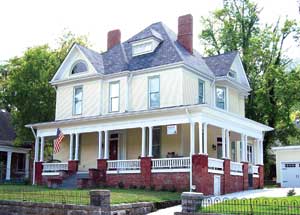Editorial
Front Page - Friday, August 6, 2010
Historic planner maintains integrity and character of neighborhoods
David Laprad
 The Chattanooga historical zoning commission oversees renovation projects in the city’s four historical neighborhoods, using guidelines the residents of the neighborhoods drew up as a basis for its decisions. The work of the commission and its staff member, Jenny Shugart, preserves the historical integrity of homes like this St. Elmo residence.
- David Laprad
The Chattanooga historical zoning commission oversees renovation projects in the city’s four historical neighborhoods, using guidelines the residents of the neighborhoods drew up as a basis for its decisions. The work of the commission and its staff member, Jenny Shugart, preserves the historical integrity of homes like this St. Elmo residence.
- David Laprad
The buildings and neighborhoods that make up Chattanooga tell two different stories. One is about the extraordinary renovation of the city in recent decades, evident along the scenic waterfront, throughout the revitalized downtown area, and in communities that have embraced a modern aesthetic. The other is about the rich history of the city, seen in the long-standing, traditional structures that line its streets.
Together, the stories tell about where Chattanooga began, and how far it has come. If Chattanooga were to lose its rich historical character, the renewal of the city would hold less value than it does today.
Jenny Shugart, historical preservation planner for Chattanooga, would never allow that to happen. As the staff member of the historical zoning commission, Shugart oversees projects that would impact the nature of the city’s four historical neighborhoods: Battery Place, Ferger Place, Fort Wood and St. Elmo. In other words, she tells homeowners what they can and cannot do to the outside of their houses.
“We deal with exterior work, so if a homeowner wants to build a deck, put up new siding, install new windows, or do a complete gut job, he has to come to us first,” Shugart says.
Despite Shugart’s good intentions, homeowners are not always receptive to her ruling on a matter.
“I’ve had people get upset with me. I’ve had people cuss me out. I let them say their piece, and then we try to find a solution,” she says.
When searching for a resolution to an impasse, Shugart refers to the neighborhood’s guidelines. Each district in Chattanooga has its own rules, drawn up by the residents of the neighborhoods, approved by the historical zoning commission and made law by the city council. At over 100 pages, St. Elmo, the largest historical district in Chattanooga, has the thickest document; the guidelines for Battery Place, a much smaller district, are thinner, but still comprehensive.
While the guidelines are law, Shugart says they contain “shoulds rather than shalls,” which gives her and a homeowner flexibility when thinking about how to approach a project.
“People think we’re strict, but that’s not accurate. There are new subdivisions in Chattanooga with covenants much stricter than our guidelines. For example, in St. Elmo, we don’t tell people which color of paint to use,” Shugart says.
Instead of forcing owners to adhere to a strict set of codes that might or might not be relevant to their home, Shugart reviews projects on a case by case basis.
“In St. Elmo, you might have a big Victorian sitting on a flat piece of land and a little bungalow up against the side of Lookout Mountain. To say things have to be done a certain way in both cases wouldn’t work,” she says.
Shugart’s objective at all times is the preservation of historical integrity, which means she sometimes has to say no.
“Vinyl siding would be inappropriate for an old house because it would cover up the parts that make it an important property. You’d end up with a plastic box instead of a nice bungalow,” she says.
More often than not, Shugart says she and a homeowner are able to reach a compromise.
“A number of people have wanted to remove original windows and put in replacement windows because someone has told them it would be more efficient. I let them know they can do interior or exterior storm windows, which are less expensive and provide the same benefit,” she says.
Preserving the historical character of a city generates more than sentimental and visual value. According to Shugart, it also helps to raise property values and attract tourists.
“Protecting these neighborhoods can stabilize or increase their property values. It’s also an important source of revenue, as heritage tourism is a huge industry. It’s a source of employment, too, although it’s getting hard to find people who can do that kind of work,” she says.
Shugart says she hopes people who live in Chattanooga will visit its historical neighborhoods so they can see firsthand the work the residents have put into preserving them.
“If you get a chance to walk through these neighborhoods, do it. St. Elmo has changed so much. It’s got a wonderful mix of young people who just moved in, right out of college and people who have lived there their entire lives,” she says.
Shugart also hopes people will come to appreciate what the historical zoning commission does for the city.
“I look at this job and our commission as resources. We’re free to the people living in these neighborhoods. They can ask us to look at something they want to do, and it doesn’t cost them a thing. We’re not here to say no; we’re here to help people find a solution that works for them and fits within the guidelines under which they are living,” she says.
|
|